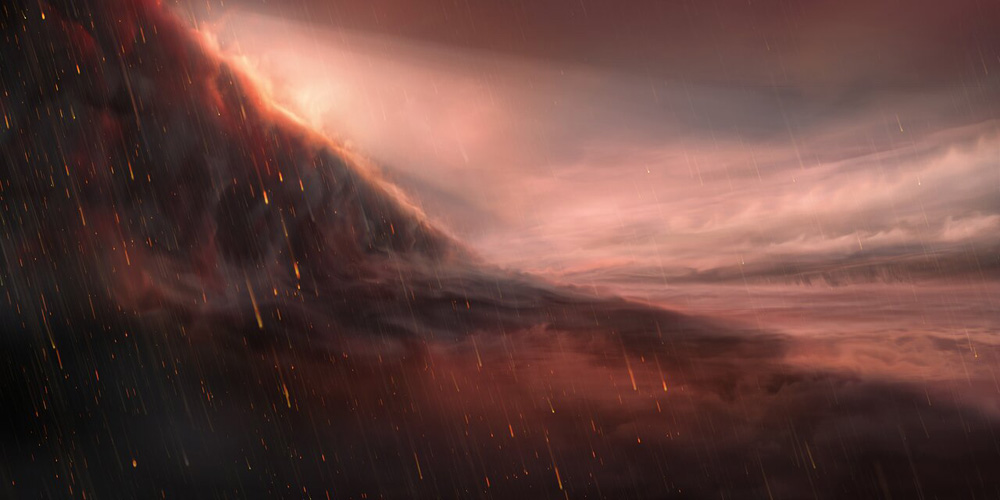New observations show a signature that could come from iron rain on one side of the ultra-hot gas giant WASP-76b.
When astronomers discovered the gas giant WASP-76b in 2016, about 640 light-years from Earth in the constellation Pisces, they already knew it was exotic. WASP-76b circles its star in only 43 hours, making it a “hot Jupiter.”
Now, a group of astronomers led by David Ehrenreich (University of Geneva, Switzerland) has found that this planet might be even stranger than we thought, hosting clouds and fog made of iron. The research appears in Nature.

ESO / M. Kornmesser
WASP-76b is tidally locked so, like the Moon, it always shows the same face toward its star. The planet’s constantly daylit side may reach 2,400°C, and even the permanent nightside only cools to 1,400°C.
The hot Jupiter crosses the face of its star from Earth’s perspective, so astronomers can take a spectrum of the starlight that passes through the planet’s atmosphere during its passes. Ehrenreich and colleagues used the ESPRESSO spectrograph mounted on the European Southern Observatory’s Very Large Telescope in the Chilean Atacama Desert. “ESPRESSO delivers a precision . . . never achieved before by any other spectrograph,” explains coauthor María Rosa Zapatero Osorio (Center of Astrobiology, Spain).
Iron Rain
The high-resolution spectrum reveals lots of iron vapor within the sliver of atmosphere undergoing the transition from day to night. However, this iron vapor signature is missing from the sliver of atmosphere transitioning from night to day. The astronomers think this happens because strong winds push iron vapor to the nightside, where it cools and condenses into clouds.
“This planet has a twilight zone at a temperature close to the iron condensation temperature,” Ehrenreich explains, “so the change in atmospheric composition (with iron vs. without iron) is occurring right where we are able to observe.”
Because the planet is a gas giant, there’s no surface onto which the droplets can fall, says coauthor Nuno Santos (University of Porto, Portugal). But the planet’s gravity likely pulls the clouds downward, enveloping the nightside in iron fog. The global winds then push the clouds and fog onto the dayside, where the vaporization-condensation cycle repeats again.
This isn't the first exoplanet with iron found in its atmosphere — the even-hotter Jupiter KELT-9b also hosts ionized iron and titanium. However, in the case of WASP-76b astronomers are finding neutral iron vapor in clouds rather than in ionized, cloud-free form.
Carole Haswell (Open University), who was not involved with the study, is excited by the new observations. She says, “These findings show that the weather conditions on exoplanets can be far stranger than we might imagine!”
 5
5









Comments
Anthony Barreiro
March 12, 2020 at 7:18 pm
A star 640 light years distant is a point source of light. A planet orbiting that star is even tinier than the star. The edges of the planet's atmosphere are vanishingly tinier. I'm trying to figure out how these researchers were able to differentiate the spectra of the two twilight zones. Is this a temporal phenomenon? Here's my mental picture:
Assume that the star is rotating in the same direction as it orbits the star, so the gas on the edge of the planet that crosses the edge of the star at the beginning of a transit is moving from the night side to the day side. The gas on the edge of the planet that crosses the edge of the star at the end of a transit is moving from the day side to the night side. So a spectrum at the beginning of a transit and another at the end of the transit show you first the night-to-day twilight zone, then the day-to-night twilight zone.
Do I have this right?
You must be logged in to post a comment.
Rcriceinc
March 13, 2020 at 4:20 pm
No.a star does not orbit a star in this case. Also, the article indicated that the planet itself does not rotate during its solar orbit.
You must be logged in to post a comment.
Anthony Barreiro
March 14, 2020 at 4:11 pm
Thanks for pointing out my typo. That should have read "the planet rotates in the same direction as it orbits the star." A tidally locked planet (or moon, like ours) rotates -- its rotational period is equal to its orbital period.
I'm still hoping that somebody who understands this specific study better than I do will either confirm my guess or explain how the two spectra are differentiated from one another.
You must be logged in to post a comment.
Monica Young
March 17, 2020 at 7:45 pm
Hi Anthony - great question! My understanding is that transit spectroscopy involves some pretty intensive data analysis. They take the spectrum of the star as the planet is passing in front of it. Then they can subtract out the star's spectrum to get the spectrum of the light passing through the atmosphere. For an instrument with really high velocity resolution, such as the one used in this study, they can differentiate where an emission line is coming from by a combination of the line's redshift/blueshift and the timing of the planet (that is, is at ingress or egress). I hope that helps!
You must be logged in to post a comment.
Anthony Barreiro
March 18, 2020 at 5:51 pm
Thanks Monica! That all makes sense. This stuff makes counting angels dancing on the head of a pin look like child's play.
You must be logged in to post a comment.
You must be logged in to post a comment.